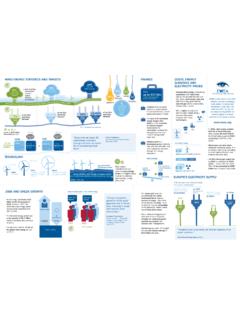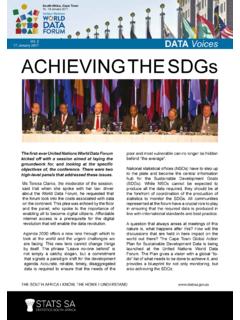Transcription of Storer & Teljeur Admin Prices Executive Report 3B
1 Administered Prices Executive Report . A Report for National Treasury DAVID Storer AND ETH L Teljeur . Preface This Report was prepared for National Treasury to support its assessment of administered Prices in South Africa. The objective of the study was to assess the processes involved in setting Prices in regulated industries. By evaluating the efficiency, effectiveness and analytical rigour of the regulatory processes involved in setting Prices for the services involved, an assessment can be made of the likelihood that the resultant tariffs approach efficient levels. Volume I of the Report sets out the main findings and recommendations with supporting information relating to the individual sectors included within the scope of the study provided in a summarised form. Volume II contains more detailed sectoral reports, covering individual review of the water, electricity, telecommunications, transport, health and education sectors.
2 The Report does not offer a detailed quantitative assessment of the performance of the regulatory regime, and is largely based on in-depth interviews and documentary analysis. The authors would like to thank the interviewees for their cooperation and valuable insights. Although much care was taken to provide a correct reflection of the opinions expressed, the authors remain entirely responsible for any inaccuracies. ADMINISTERED Prices . Executive Report 1. INTRODUCTION. Objectives This Report covers the findings and conclusions of a study carried out for National Treasury focusing on the price determination processes in several regulated sectors. The findings relate to a set of exercises commissioned by National Treasury, covering price determination in the telecommunications, water, electricity, health and education sectors. The objective of the study was to assess the processes involved in setting Prices South Africa.
3 By evaluating the efficiency, effectiveness and analytical rigour of the regulatory processes involved in setting Prices for the services involved, an assessment can be made of the likelihood that the resultant tariffs approach efficient levels. In economic theory, efficient Prices are defined as Prices that approach marginal cost , which is the level achieved under perfectly competitive conditions. Economic regulation is generally introduced when market failures prevent effective competition and is aimed at mimicking the competitive conditions to steer Prices towards efficient levels. Network industries such telecommunications, electricity, water and transport have a strong natural monopoly component, namely the grid or network, which generally cannot viably be duplicated, thereby constituting a market failure that justifies economic regulation. This said, the particular characteristics that result in market failure strong economies of scale and consequent natural monopoly tendencies in key components of their overall activity chains mean that second best' pricing structures will often be necessary.
4 Thus the best' achievable efficient' cost -reflective Prices in these sectors will necessarily represent a compromise given the need to mark up marginal cost Prices in order to recover total costs. The overall aim of the study was to evaluate the efficacy of the price determining processes that are in place for these important sectors and the issues that arise for the future regulation of these sectors in South Africa. Hence, this study does not attempt to assess the efficiency of the absolute price levels, but rather aims to assess whether the current regulatory processes are likely to result in efficient pricing. If well-implemented, economic regulation should lead to efficient Prices in terms of both the overall level at which Prices are set and of the relative structure of Prices for different services or volumes of usage. Efficient pricing is not necessarily synonymous with price reduction although well designed price control approaches will provide incentives for productive efficiency that other things being equal should result in lower costs and lower Prices .
5 But poor price administration procedures may also lead to Prices that are inefficient because they are set, unsustainably, below a level that would 1. adequately reflect efficient costs. A key finding of this review is that administered price setting in SA can not, by and large, be expected to lead to efficient Prices . A key, conclusion, however, is that the appropriate solution is not to substitute the existing systems with the blunt instrument of an across the board inflation cap, which would make matters worse, but to work to improve them so that they can function more effectively. The Report includes conclusions and some preliminary recommendations for improvements to the current price determination processes. The Report focuses on the processes involved in determining Prices , not the actual price levels themselves. An analysis of the institutional and procedural framework was complemented by an assessment of the practical forces impacting on price levels in an industry, which may or may not be captured in the official decision making framework.
6 For example, public opinion may be an important effective cap' on Prices of infrastructure services, although this force may not feature prominently in the regulatory framework. Likewise ministerial approval of tariffs could in practice entail anything from heavy-handed ministerial interference to a procedural rubber-stamping'. mechanism. It is important to note that the need for and effectiveness of price regulation depends to a large extent on factors exogenous to the price setting process, such as (i) sector structure and market design, including the degree of vertical or horizontal integration and the extent to which competition is encouraged where this is economically feasible; (ii) the ability of government to adequately control the behaviour of state-owned enterprises without regulation; and (ii) government policy objectives regarding the transport sectors, including social imperatives.
7 Scope The study was prompted by several public statements regarding administered Prices ' by the Minister of Public Enterprises, the Minister of Finance, the Reserve Bank Governor and ANC MPs1 between March and May 2002. In this public debate the term administered Prices ' related to all Prices for services provided by state-owned enterprises or those regulated by organs of the state. The Minister of Public Enterprises, prompted by concerns expressed by the Reserve Bank Governor regarding the effect of rising administered Prices , such as of electricity Prices , on South Africa's ability to meet its inflation targets, made several statements regarding price increases proposed by parastatals. Furthermore, in response to price hikes implemented by Eskom, Telkom and Spoornet, the Minister of Public Enterprises emphasised the need for a uniform approach to tariffs by parastatals to avoid placing government's inflation targets in jeopardy.
8 One of the options under consideration was including inflation targets or restraints on tariff increases in the shareholder compacts of state-owned enterprises. In addition to financial criteria, the shareholder compacts should stipulate development aspects, including investment plans and affirmative procurement. 2. 1. Ensor, Linda (2003), State Considers Inflation target Limits on Tariff Increase, Business Day 20 March 2003. 2. Ensor, Linda (2003), State Considers Inflation target Limits on Tariff Increase, Business Day 20 March 2003. 2. The debate was extended to include public sector wages and suggestions of a universal cap on administered Prices were raised. The Minister of Finance responded to this debate by placing on record that Government would not put a cap on administered Prices or public sector wages, as there were legitimate factors that had to be balanced against inflation This study includes some consideration of such legitimate factors.
9 As other publicly provided services, such as health and education services that typically suffer from market failures, also have a large impact on disposable income and potentially on inflation, the spectrum of industries that were assessed in this study was widened to include these two sectors in addition to the electricity, water, telecommunications and transport Although conventionally not considered a network industry, the question of control over Prices in these sectors is an important one that falls within the ambit of the debate around administered Prices . Methodology The Report uses official documents and policy statements, complemented by extensive interviews with government officials, service providers and stakeholders. By its very nature, this Report is a qualitative and unavoidably judgemental assessment of the price setting mechanisms in the transport sectors under review.
10 The assessments contained in this document are based on the views expressed by sources holding divergent opinions but great care has been taken to produce a balanced view. All views expressed as well as any inaccuracies - in this Report remain entirely the responsibility of the authors. 3. Ensor, Linda (2003), Inflation Goals not to Hamper Wage Rises, Business Day 23 May 2003. 4. The sectors under review differ from the composition of the administered price index' by Statistics South Africa, which includes a large petrol cost component in the transport weighting and which includes only public hospitals under health costs, not medical aid or medicines costs. In order to assess the sectors in a coherent manner, the regulatory approach for the network part of the industries was focussed on in this study. Thus, the transport section includes ports and aviation charges in addition to train tariffs.












